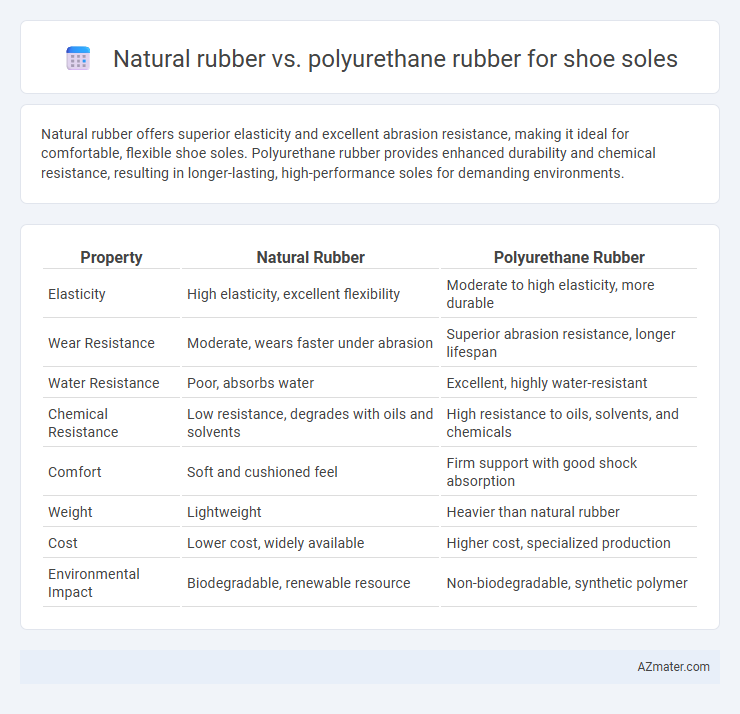Natural rubber offers superior elasticity and excellent abrasion resistance, making it ideal for comfortable, flexible shoe soles. Polyurethane rubber provides enhanced durability and chemical resistance, resulting in longer-lasting, high-performance soles for demanding environments.
Table of Comparison
| Property | Natural Rubber | Polyurethane Rubber |
|---|---|---|
| Elasticity | High elasticity, excellent flexibility | Moderate to high elasticity, more durable |
| Wear Resistance | Moderate, wears faster under abrasion | Superior abrasion resistance, longer lifespan |
| Water Resistance | Poor, absorbs water | Excellent, highly water-resistant |
| Chemical Resistance | Low resistance, degrades with oils and solvents | High resistance to oils, solvents, and chemicals |
| Comfort | Soft and cushioned feel | Firm support with good shock absorption |
| Weight | Lightweight | Heavier than natural rubber |
| Cost | Lower cost, widely available | Higher cost, specialized production |
| Environmental Impact | Biodegradable, renewable resource | Non-biodegradable, synthetic polymer |
Introduction: Purpose of Comparing Natural Rubber and Polyurethane Rubber
Comparing natural rubber and polyurethane rubber for shoe soles highlights differences in durability, flexibility, and cost-efficiency relevant to footwear performance. Natural rubber excels in elasticity and abrasion resistance, making it ideal for comfort and grip in casual shoes. Polyurethane rubber offers superior wear resistance and chemical stability, favored in industrial and sports footwear for enhanced longevity.
Chemical Composition and Manufacturing Processes
Natural rubber, derived from latex of Hevea brasiliensis, consists primarily of cis-1,4-polyisoprene, which provides high elasticity and resilience in shoe soles. Polyurethane rubber is a synthetic polymer produced through the chemical reaction between diisocyanates and polyols, resulting in diverse hardness and abrasion resistance tailored for shoe sole applications. Manufacturing natural rubber soles involves processes like vulcanization to enhance durability, whereas polyurethane soles are molded via casting or injection molding, allowing more precise control over mechanical properties.
Durability and Wear Resistance
Natural rubber offers excellent elasticity and resilience but tends to wear out faster under abrasive conditions, limiting its durability for heavy-use shoe soles. Polyurethane rubber provides superior wear resistance and higher durability, maintaining structural integrity on rough surfaces for prolonged periods. The enhanced abrasion resistance and toughness of polyurethane make it a preferred material for high-performance footwear requiring long-lasting soles.
Flexibility and Comfort Evaluation
Natural rubber offers superior flexibility due to its high elasticity and ability to stretch without losing shape, making it ideal for shoe soles requiring comfort during prolonged wear. Polyurethane rubber provides excellent cushioning and durability but tends to be stiffer, which may reduce flexibility and impact the overall comfort of the shoe. Studies show natural rubber soles adapt better to foot movements, enhancing comfort by reducing foot fatigue compared to the firmer polyurethane variants.
Grip and Traction Performance
Natural rubber offers superior grip on wet and slippery surfaces due to its high resilience and excellent friction properties, making it ideal for shoe soles requiring strong traction. Polyurethane rubber, while more abrasion-resistant and durable, provides moderate grip but excels in maintaining traction on dry surfaces and uneven terrains. Choosing between the two depends on the specific performance needs, with natural rubber favored for wet conditions and polyurethane suited for durability and versatile traction.
Environmental Impact and Sustainability
Natural rubber offers superior biodegradability and renewability as it is derived from rubber trees, making it a more sustainable choice for shoe soles compared to polyurethane rubber, which is petroleum-based and non-biodegradable. Polyurethane soles contribute to higher carbon emissions during production and generate long-lasting landfill waste, posing environmental challenges. Choosing natural rubber supports reduced ecological footprints and promotes sustainable material cycles in footwear manufacturing.
Cost Analysis and Affordability
Natural rubber offers a lower production cost for shoe soles due to its abundant raw material availability and simpler processing methods, making it more affordable for mass-market footwear. Polyurethane rubber, while more expensive because of complex chemical synthesis and higher raw material costs, delivers superior durability and abrasion resistance, which can reduce replacement frequency and long-term expenses. Cost analysis shows that natural rubber is ideal for budget-conscious consumers, whereas polyurethane is favored for high-performance shoes where durability justifies the initial investment.
Applications in Various Types of Footwear
Natural rubber offers excellent flexibility, abrasion resistance, and slip resistance, making it ideal for casual and athletic shoe soles that require high comfort and durability in diverse environments. Polyurethane rubber provides superior wear resistance, cushioning, and lightweight properties, often used in hiking boots, work shoes, and performance footwear where enhanced shock absorption and support are critical. Both materials cater to specific footwear needs, with natural rubber favored for flexibility in everyday wear and polyurethane preferred for specialized applications requiring endurance and comfort.
Maintenance, Cleaning, and Longevity
Natural rubber shoe soles require regular cleaning with mild soap and water to prevent surface degradation, while polyurethane rubber soles resist stains and dirt, allowing for easier cleaning with just a damp cloth. In terms of maintenance, natural rubber is prone to cracking and hardening over time, especially if exposed to ozone or UV light, necessitating more frequent conditioning; polyurethane soles exhibit superior resistance to abrasion and chemical exposure, reducing the need for intensive upkeep. Polyurethane rubber typically offers longer longevity due to its enhanced durability and resistance to wear, whereas natural rubber soles may wear down faster in high-friction environments, impacting overall shoe lifespan.
Conclusion: Best Choice for Shoe Soles
Polyurethane rubber outperforms natural rubber in shoe soles due to its superior abrasion resistance, durability, and flexibility, making it ideal for high-performance footwear. Natural rubber offers excellent elasticity and environmental benefits but tends to wear faster and can degrade with prolonged moisture exposure. For long-lasting, comfortable, and versatile shoe soles, polyurethane provides the best balance of performance and lifespan.

Infographic: Natural rubber vs Polyurethane rubber for Shoe sole
 azmater.com
azmater.com